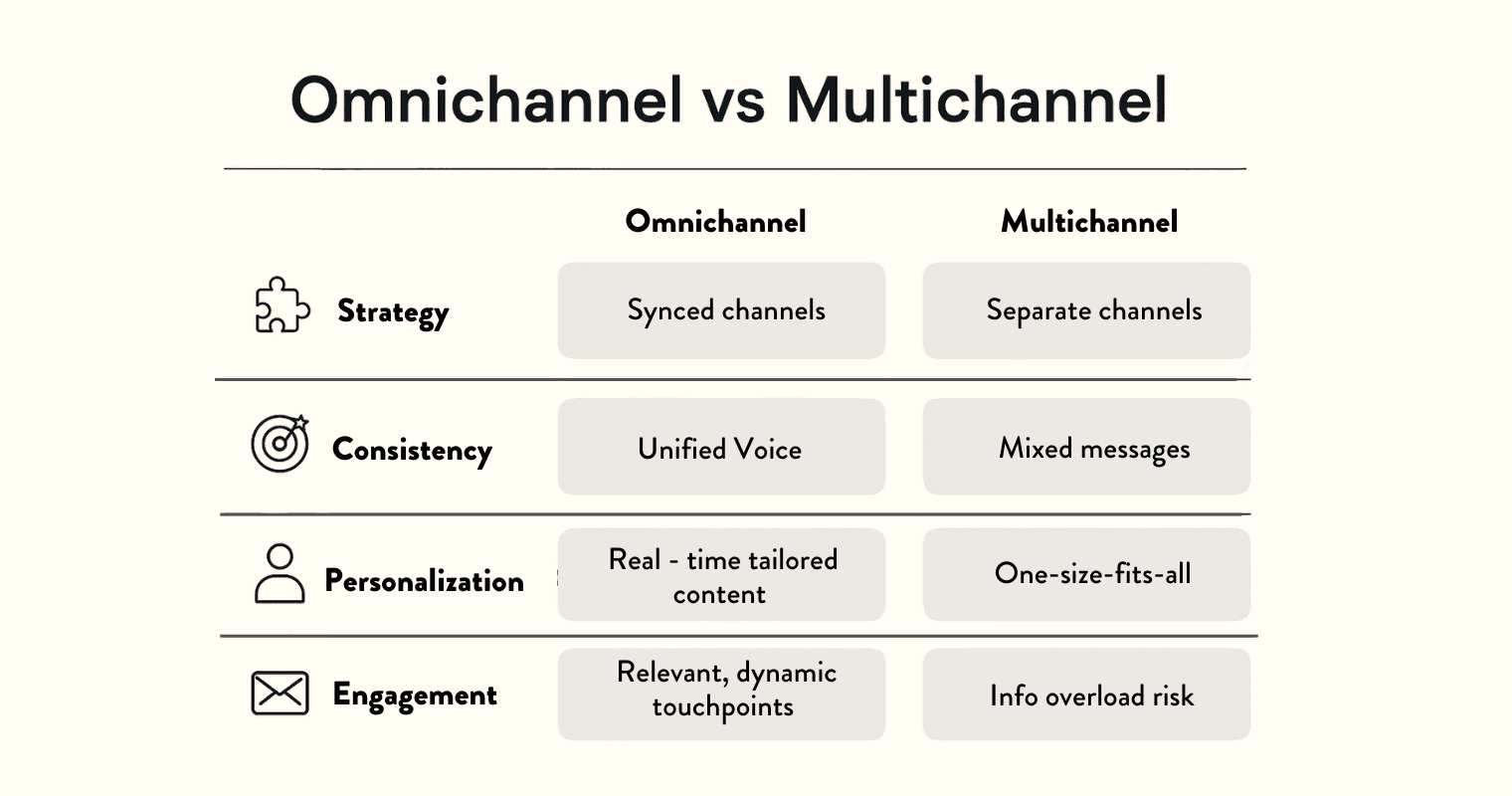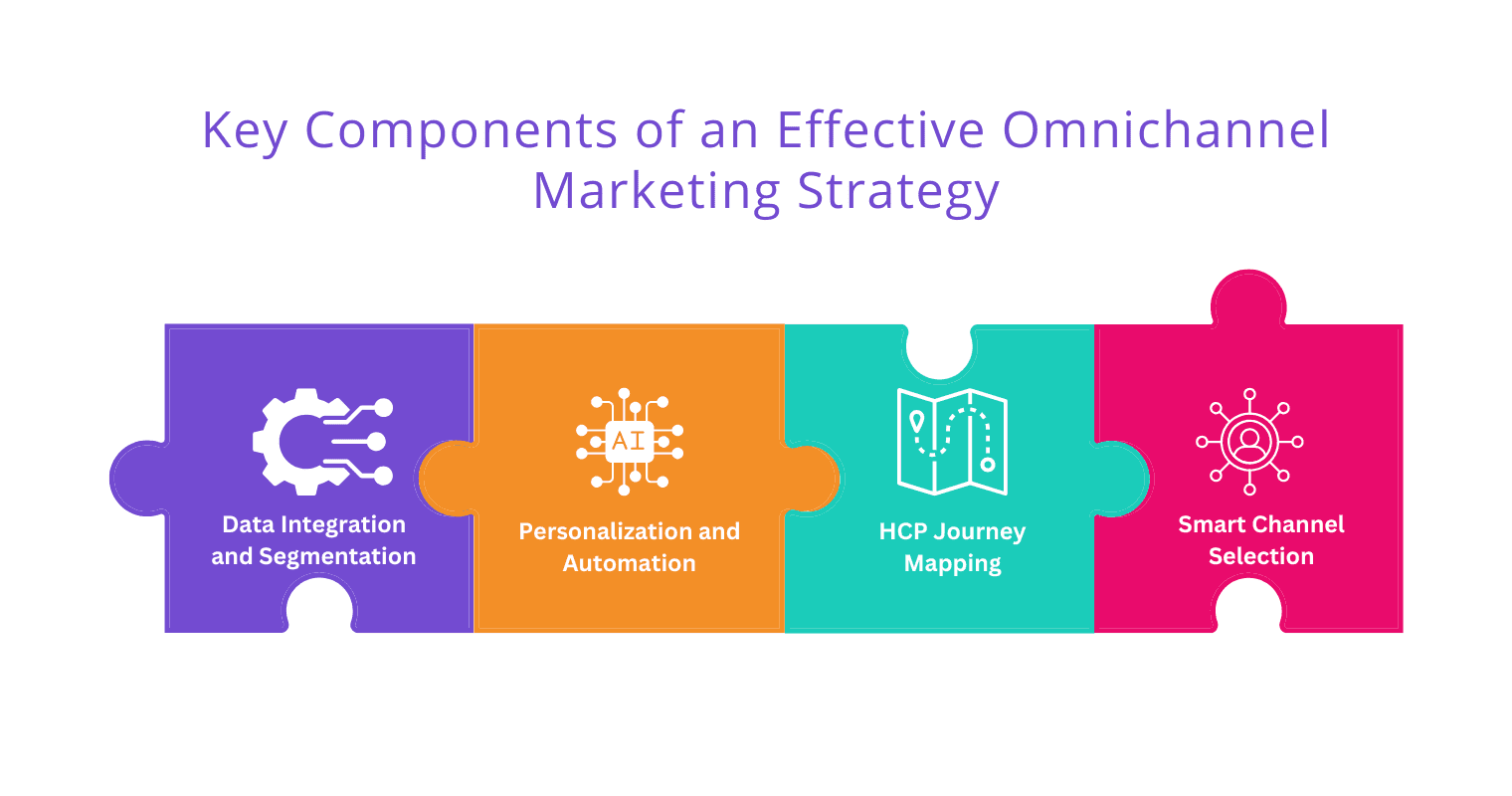Omnichannel Marketing in Pharma: What’s Actually Working in 2025

by Kathleen McQuade | Last Updated: April 15, 2025 | 1 min read
Omnichannel Marketing is transforming how pharmaceutical and life sciences companies connect with healthcare professionals (HCPs). Unlike traditional single-channel outreach, Omnichannel Marketing offers a seamless and personalized experience across multiple platforms - email, Text Message, video calls, and face-to-face visits. This integrated approach ensures that messages reach the right HCP at the right time and through the most effective channel.
In today’s evolving Life Sciences Marketing landscape, the need for deeper, more meaningful connections with HCPs is critical. Relying on isolated efforts no longer delivers results. Omnichannel Marketing breaks down these silos and empowers companies to deliver unified, context-rich communications that foster trust and engagement.
This shift is vital because HCPs today expect convenience, consistency, and value. With Omnichannel Marketing, brands can streamline their communication strategy and optimize each interaction. Whether the HCP prefers a quick text message update, a detailed email, or a live video discussion, the journey remains smooth and interconnected.
The relevance of HCP Engagement cannot be overstated. Better engagement leads to better education, stronger relationships, and improved patient outcomes. And the key to achieving this lies in a well-executed Omnichannel Marketing strategy.
Adopting strong Pharma Marketing Strategies involves understanding how each channel contributes to the overall engagement goal. The focus should be on delivering insights rather than just information. This makes Omnichannel Marketing not just a tactic, but a long-term strategic pillar for growth.
As a result, Omnichannel Marketing is no longer optional - it’s essential. It supports compliance, elevates brand credibility, and enables more efficient workflows. It’s the foundation for modern Life Sciences Marketing and the best messaging platform for patient engagement and communication.
For pharma professionals seeking to modernize their outreach, Omnichannel Marketing provides both the vision and the path forward.
What Makes Omnichannel Marketing Different from Multichannel

Omnichannel Marketing has become a core focus in the pharmaceutical and life sciences marketing world. But to truly understand its value, it’s important to differentiate it from multichannel marketing, which has been the norm for many years.
What Is Multichannel Marketing?
Multichannel marketing involves using multiple separate channels to reach an audience. These channels can include email, websites, mobile apps, or visits from sales reps. Each channel works independently, with little coordination or data sharing between them. As a result, healthcare professionals (HCPs) often receive overlapping or inconsistent messages, which can lead to confusion and reduce the effectiveness of the communication.
What Is Omnichannel Marketing?
Omnichannel marketing is a unified approach that connects all communication channels to deliver a seamless experience for healthcare professionals (HCPs). Unlike multichannel marketing, where each channel operates separately, omnichannel ensures that all touchpoints - email, text messages, video calls, websites, and in-person visits—are integrated and aligned. This allows pharma brands to share consistent, personalized messages based on the HCP’s preferences and behaviors. The result is stronger engagement, better coordination between teams, and a more efficient marketing strategy.
Omnichannel vs. Multichannel: Key Differences
-
Consistency: Omnichannel ensures messaging stays consistent across all channels, unlike multichannel, where content may vary.
-
Personalization: Omnichannel tracks user behavior and tailors' messages based on HCP preferences and responses.
-
Integration: Channels talk to each other in real time, leading to better HCP engagement and improved communication efficiency.
In the pharmaceutical space, where compliance and clarity are critical, Omnichannel Marketing provides structure, strategy, and results. It supports pharma marketing strategies by aligning content with the HCP’s journey. This integrated approach not only reduces message fatigue but also strengthens trust and responsiveness.
Explore More Relevant Articles on P360
- Why Pharmaceutical Companies Need to Prioritize Customer Experience (CX) Initiatives
- Say No to Apps, Portals and Logins for Effective Physician Engagement
- ZING Powers HCP Engagement With Intelligent Bots and QR Codes
- The ZING Engagement Suite Makes Scheduling with HCPs a Breeze
- Compliance Enabled SMS Messaging with HCPs is Possible
Driving Better HCP Engagement
For marketers in the life sciences industry, delivering value through relevant content is key. Omnichannel Marketing makes this easier by helping teams coordinate efforts and align sales with marketing. In doing so, brands can achieve better reach, deeper HCP engagement, and more meaningful conversations.
When combined with the best messaging platform for HCP and patient engagement, Omnichannel Marketing unlocks a powerful pathway to build strong relationships with providers. It allows pharma companies to meet HCPs and patients where they are - on the channels they prefer - at the moment they need information.
Key Components of an Effective Omnichannel Marketing Strategy

To drive consistent results in the life sciences industry, an Omnichannel Marketing strategy must be structured, flexible, and data driven. It must also align sales and marketing teams to deliver a seamless HCP experience. Below are the key components that define a successful Omnichannel Marketing framework.
1. Data Integration and Segmentation
A strong Omnichannel Marketing strategy starts with unified data. When data from different sources - CRM, digital touchpoints, rep activities - are integrated, a single view of the HCP is created.
-
Segmentation helps target different HCP personas.
-
Behavior patterns and interaction history allow personalized messaging.
-
Integrated data improves alignment between sales and marketing teams.
This foundation enables Pharma Marketing Strategies to become more agile and accurate.
2. Personalization and Automation
Omnichannel Marketing requires tailored experience. Personalization ensures that every message is relevant to the HCP's specialty, preferences, and stage in the engagement journey.
-
Marketing automation helps scale personalization.
-
Personalized content improves HCP engagement and response rates.
-
Dynamic triggers enable real-time messaging based on HCP behavior.
This level of personalization builds trust and positions your brand as a valuable resource in Life Sciences Marketing.
3. HCP Journey Mapping
Mapping the journey is essential to know when, where, and how to connect with HCPs. A clear journey map ensures that Omnichannel Marketing efforts stay consistent throughout the buying or prescribing cycle.
-
Identify key touchpoints from awareness to conversion.
-
Align messaging with HCP needs at each stage.
-
Avoid content fatigue with optimized frequency and formats.
Journey mapping ensures that Pharma Marketing Strategies are rooted in real HCP expectations and behavior.
4. Smart Channel Selection
Choosing the right mix of channels is critical. Omnichannel Marketing thrives when it uses preferred channels for each HCP, offering flexibility without overwhelming them.
-
Email for detailed communication
-
Text Messages for quick updates
-
Video calls for in-depth discussions
-
Rep visits for personal connection
This approach makes it easier to use the best messaging platform for HCP and patient engagement as part of a wider strategy.
With the right components in place, Omnichannel Marketing becomes more than a tactic - it becomes a sustainable competitive advantage. It drives deeper HCP engagement, supports scalable Pharma Marketing Strategies, and reinforces the value of consistent, data-driven communication in Life Sciences Marketing.
Challenges Faced by Pharma Companies in Implementing Omnichannel Marketing

Implementing Omnichannel Marketing in the pharmaceutical industry comes with unique challenges. While the benefits are clear—improved HCP engagement, better personalization, and stronger ROI—the road to full adoption is complex. For many life sciences brands, overcoming these hurdles is essential to scale modern pharma marketing strategies and stay competitive.
Navigating Regulatory Compliance
One of the most pressing challenges in Omnichannel Marketing is ensuring compliance with industry regulations. The life sciences industry must follow strict guidelines for content, consent, and communication. With multiple channels in play, maintaining consistency and adhering to compliance rules becomes difficult.
Each email, SMS, or digital interaction must be tracked and approved. Without a structured compliance process, pharma marketing strategies may face delays or risks of non-compliance. This makes it critical to use platforms that have pre-approved templates and built-in audit trails.
Dealing with Siloed Data Systems
Effective Omnichannel Marketing depends on clean, connected data. However, many pharmaceutical companies still operate with siloed systems. Sales, marketing, and medical affairs often use different platforms, making it hard to create a single view of the HCP.
Disconnected systems limit visibility into preferences, behaviors, and engagement history. This lack of data integration weakens personalization, reduces HCP engagement, and undermines strategic planning. Unifying data systems must be a top priority for modern life sciences marketing teams.
Managing Change and Internal Resistance
Adopting Omnichannel Marketing requires a cultural shift. Teams must align around shared goals, unified messaging, and customer-centric thinking. However, internal resistance is common, especially when moving away from traditional outreach methods.
Sales and marketing teams may be hesitant to adopt new workflows or technologies. Training, communication, and leadership buy-in are crucial for overcoming this resistance. Without internal alignment, even the best pharma marketing strategies may fall short.
Budget Constraints and ROI Concerns
Although Omnichannel Marketing promises strong returns, the initial investment can be high. Building integrated platforms, training teams, and developing content across multiple channels requires time and resources.
Leadership often questions the ROI of such investments. To address this, life sciences companies must track key performance indicators and demonstrate how Omnichannel Marketing drives measurable outcomes like increased HCP engagement and campaign efficiency.
Despite these challenges, the shift to Omnichannel Marketing is both necessary and strategic. With the right tools and planning, pharma brands can overcome these barriers and create compliant, efficient, and scalable pharma marketing strategies—all while improving their position in life sciences marketing.
Best Practices for Driving HCP Engagement Through Omnichannel Approaches
Creating a successful Omnichannel Marketing strategy depends on how well pharma companies understand and engage with healthcare professionals. In the complex world of life sciences marketing, a one-size-fits-all approach no longer works. Instead, personalization, timing, and technology are key to improving HCP engagement.
Understand HCP Behavior and Preferences
The first step in Omnichannel Marketing is understanding your audience. Every HCP has unique preferences - some prefer emails, others prefer text message or in-person meetings. Identifying these preferences allows brands to deliver messages that feel timely and relevant.
Key actions:
-
Use CRM tools to track engagement history.
-
Segment HCPs by specialty, region, and preferred channels.
-
Avoid generic messages. Instead, tailor content to each HCP’s needs.
This approach not only improves HCP engagement but also helps refine your pharma marketing strategies.
Focus on Timing and Relevance
In Omnichannel Marketing, timing is as important as content. Messages should be sent when the HCP is most likely to engage. This increases open rates, click-throughs, and overall interest.
Best practices:
-
Use AI-powered analytics to determine optimal sending times.
-
Avoid message fatigue by spacing out touchpoints.
-
Match messaging to the HCP’s journey phase - education, decision-making, or support.
Timely communication improves brand recall and strengthens the connection between pharma reps and HCPs.
Blend Physical and Digital Engagements
Modern Omnichannel Marketing combines the power of digital tools with traditional in-person interactions. This blend enhances communication and provides flexibility for HCPs to engage how and when they choose.
Effective combinations:
-
Follow up in-person visits with a personalized email.
-
Schedule a video call after a product webinar.
-
Use SMS to share quick reminders or updates.
This integration helps deliver a seamless brand experience and supports better HCP engagement across all stages.
Leverage CRM and AI-Powered Platforms
Using technology is critical to scale and optimize Omnichannel Marketing. CRM systems, when integrated with AI, provide real-time insights that allow marketers to adjust strategies instantly.
Benefits include:
-
Better targeting through data-driven segmentation.
-
Real-time performance tracking of touchpoints.
-
Adaptive learning for continuous campaign improvements.
This not only improves the effectiveness of pharma marketing strategies but also ensures compliance, consistency, and better ROI.
By applying these best practices, pharma brands can maximize their Omnichannel Marketing efforts. When paired with the best messaging platform for patient engagement, these strategies deliver stronger results, deeper connections, and long-term value in life sciences marketing.
Role of Data and Analytics in Life Sciences Marketing
Data and analytics form the backbone of effective Omnichannel Marketing in today’s life sciences marketing environment. For pharmaceutical companies, using the right data helps align sales and marketing teams, refine outreach strategies, and improve HCP engagement at scale.
Real-Time Insights for Smarter Decisions
In Omnichannel Marketing, success depends on real-time data. Campaigns can be optimized instantly when marketers can see which messages work and which channels perform best. Using platforms that provide live analytics allows teams to respond quickly to shifting trends and behavior.
Key advantages:
-
Track content performance across email, Text Message, and in-person visits.
-
Optimize top-performing channels and drop underperforming ones.
-
Personalize future touchpoints based on response rates.
This approach supports adaptive pharma marketing strategies that focus on timely delivery and relevance.
Setting and Monitoring KPIs
Well-defined KPIs are critical in Omnichannel Marketing. Metrics such as open rates, click-through rates, engagement rate, duration, and meeting outcomes help measure campaign success. These insights not only guide content decisions but also align teams toward shared business goals.
Examples of effective KPIs:
-
Response rate by channel
-
Average HCP interaction time
-
Engagement frequency per HCP
Tracking these KPIs builds accountability and ensures HCP engagement remains a top priority throughout the campaign lifecycle.
Segmentation Based on HCP Interests
Advanced segmentation is another pillar of successful Omnichannel Marketing. By analyzing interaction history, behavior, and preferences, marketers can create more personalized campaigns. Instead of generic messaging, every HCP receives content that matches their interests and current needs.
Benefits of segmentation:
-
Increases relevance and value of communications
-
Reduces message fatigue among HCPs
-
Improves overall performance of pharma marketing strategies
-
Segmentation not only strengthens HCP engagement but also ensures better use of resources.
By combining data, analytics, and personalized strategies, Omnichannel Marketing becomes more effective. When powered by the best messaging platform for HCP and patient engagement, this approach helps pharma brands drive stronger outcomes and meet the expectations of modern healthcare professionals in the life sciences marketing space.
Future Trends in Pharma Marketing and Omnichannel Engagement

As the pharmaceutical landscape evolves, so do expectations around communication and personalization. Emerging technologies are redefining how Omnichannel Marketing is executed in the life sciences marketing space. From AI to deeper data integration, companies are investing in scalable solutions that align better with modern pharma marketing strategies and enhance HCP engagement.
The Rise of Conversational AI in Omnichannel Marketing
Conversational AI is becoming an integral part of Omnichannel Marketing. Chatbots, voice assistants, and AI-powered messaging tools now deliver real-time responses to HCPs. These systems can answer medical queries, provide product updates, and even schedule meetings with reps.
Benefits include:
-
24/7 availability across digital channels
-
Consistent messaging that supports compliance
-
Enhanced HCP engagement through interactive experiences
When added to an Omnichannel Marketing mix, conversational AI boosts responsiveness and strengthens long-term relationships.
Predictive Engagement to Anticipate HCP Needs
Predictive analytics plays a key role in shaping proactive Omnichannel Marketing efforts. By analyzing past behaviors, AI tools can forecast future actions and trigger timely responses.
Use cases:
-
Sending personalized content before an HCP requests it
-
Identifying disengaged HCPs and reactivating them
-
Aligning touchpoints with HCP preferences
This approach supports data-driven pharma marketing strategies that focus on meeting HCPs where they are.
Compliance-Led Personalization Is the New Standard
In regulated industries like pharma, personalization must comply with local and global guidelines. Omnichannel Marketing solutions are now being built with embedded compliance features, allowing teams to customize messaging while adhering to standards.
Key features:
-
Pre-approved templates
-
Role-based access to sensitive content
-
Automated audit trails
This ensures that personalization is achieved without compromising legal or ethical boundaries. As a result, HCP engagement is improved with confidence and transparency.
Integration with EHR Systems Enhances Relevance
Omnichannel Marketing platforms are increasingly being integrated with Electronic Health Record (EHR) systems. This enables real-time syncing of data, helping marketers better understand the clinical context of their audience.
Advantages:
-
Content delivery based on treatment patterns
-
Triggered messaging aligned with diagnosis or prescription events
-
Greater insight into patient outcomes
With this integration, life sciences marketing campaigns can be more informed and personalized-creating better alignment between sales and medical teams.
The future of Omnichannel Marketing in pharma is tech-driven, compliant, and deeply personalized. When supported by the best messaging platform for HCP and patient engagement, these trends empower companies to create consistent, relevant, and timely experiences for HCPs - ultimately improving engagement and outcomes across the board.
How ZING Engagement Suite by P360 Powers Smarter Omnichannel Marketing
In the evolving world of life sciences marketing, success depends on how well pharma companies can implement effective Omnichannel Marketing. ZING by P360 offers a specialized platform built for this very purpose. It helps life sciences teams streamline communication, reduce waste, and enhance HCP engagement—all while staying compliant.
What Is ZING Engagement Suite?
ZING is an advanced communication and engagement platform designed specifically for the pharmaceutical industry. Built with modern pharma marketing strategies in mind, ZING enables personalized, scalable, and compliant Omnichannel Marketing experiences across all customer touchpoints.
Integration Across Channels
ZING seamlessly integrates key engagement channels such as Text message, video calling, and in-person rep visits. These channels are not used in isolation. Instead, they are connected within a unified framework. ZING Engagement Suite seamlessly integrates with preferred messaging platforms like Text Message, WhatsApp, Viber, Line, and KakaoTalk. This allows brand teams and field reps to deliver consistent messaging—an essential part of successful Omnichannel Marketing.
Every HCP receives tailored content on the platform they prefer, at the time they prefer. This approach helps increase attention, trust, and ultimately, better engagement.
Built-In Compliance for Pharma Marketing Strategies
Compliance is built into the core of ZING Engagement Suite. Pre-configured templates, audit logs, and role-based content access ensure that Omnichannel Marketing efforts remain within legal and regulatory boundaries. This allows marketing teams to personalize messaging without the risk of non-compliance.
ZING Engagement Suite eliminates guesswork and manual review processes, making it easier to scale pharma marketing strategies while maintaining quality and integrity.
Real-Time Analytics and HCP Profiling
One of the most powerful features of ZING Engagement Suite is its analytics engine. Teams can access real-time data about how each channel and message is performing. From open rates to rep interaction insights, everything is tracked and visualized.
Additionally, advanced HCP profiling allows teams to better understand their audience. With these insights, Omnichannel Marketing efforts become more precise and efficient.
Key advantages:
-
Campaigns are adjusted in real time based on HCP responses
-
Future touchpoints are tailored using data-driven insights
-
HCP engagement increases due to better personalization
Tangible Outcomes for Life Sciences Brands
ZING Engagement Suite helps reduce marketing waste by eliminating ineffective outreach and focusing resources where they matter most. Pharma companies using ZING have seen stronger HCP engagement, better alignment between sales and marketing, and improved ROI from their Omnichannel Marketing efforts.
By supporting personalized, compliant, and measurable communication, ZING Engagement Suite positions itself as the best messaging platform for HCP Engagement, patient engagement and professional communication in the life sciences sector.